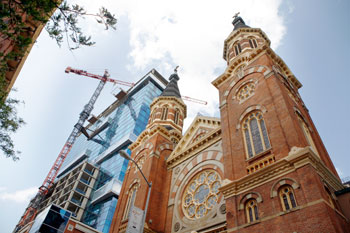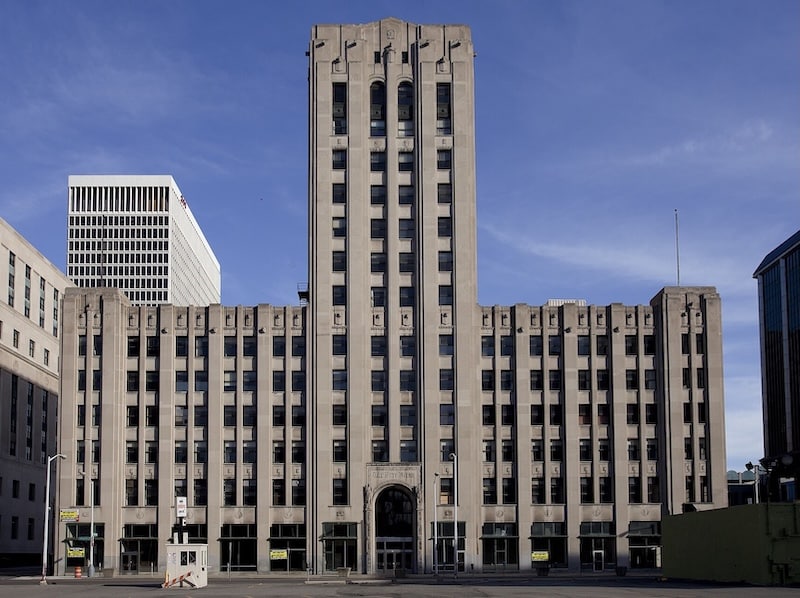Does Detroit Need Another Icon?
For thousands of years, people have built spectacular projects to
attract visitors, spur commerce and bring status to their cities and
countries. So is it time for Detroit to build a new icon?
 My friend Brian asked me why Detroit doesn’t have a provocative, spectacular museum or concert hall, some iconic, tourist attracting, knock-your-socks-off statement of a building like some cities have recently built. It’s true; we haven’t built an iconic structure in Detroit since the Renaissance Center in 1974.
My friend Brian asked me why Detroit doesn’t have a provocative, spectacular museum or concert hall, some iconic, tourist attracting, knock-your-socks-off statement of a building like some cities have recently built. It’s true; we haven’t built an iconic structure in Detroit since the Renaissance Center in 1974.
Always out to bring creative culture and dollars to Detroit, he hinted that we need one of these to compete, to be up there with the other big towns. So if Milwaukee has its Calatrava, Minneapolis has its Herzog and de Meuron, Seattle has its Koolhaas, and Bilbao (Spain) has its Gehry, we need our “starchitect” building, too.
This impulse is not new. For thousands of years, people have built spectacular projects to attract visitors, spur commerce and convey status on their cities and countries. The Eiffel Tower, built for the World Exposition of 1900, is such a structure. Gothic cathedrals were built in the Middle Ages to attract pilgrims, each competing to be the tallest, thinnest and most ornate. The great pyramids of Egypt were built to convey the status and power of Egyptian pharaohs. I also suspect there were more than a few Egyptian bureaucrats who saw their possible economic benefits as well. After all, the pyramid’s primary function today is to attract tourist dollars. This impulse to show the world your mettle through extravagant construction, to have the best and biggest and most amazing building, seems to be human nature. Hannah Arendt, a social philosopher, uses the Latin phrase Homo Faber to describe Man as builder. It’s true: We love to build.
Let’s redirect Brian’s question a bit. It’s not, “Why don’t we build an icon in Detroit”; it’s, rather, “Is an icon worth the money? Would it be a good use of resources?”  As an architect, I love and hate icon buildings. They often embody the latest in architectural thought and technology. A Frank Gehry building is a technical tour de force. It is a complex sculpture created with aerospace design software and computer aided manufacturing methods. But it is also obscenely expensive, resource intensive and often rather jarring to the senses. In fact this is a requirement of an icon: To be inspiring sculpture more than useful space. These buildings need to be somewhat unfriendly and provocative to be effective. That’s their nature. It becomes an icon by breaking the mold. As a creative sort, this is very appealing.
As an architect, I love and hate icon buildings. They often embody the latest in architectural thought and technology. A Frank Gehry building is a technical tour de force. It is a complex sculpture created with aerospace design software and computer aided manufacturing methods. But it is also obscenely expensive, resource intensive and often rather jarring to the senses. In fact this is a requirement of an icon: To be inspiring sculpture more than useful space. These buildings need to be somewhat unfriendly and provocative to be effective. That’s their nature. It becomes an icon by breaking the mold. As a creative sort, this is very appealing.
This is the true value of the icon. It’s not in the fleeting tourist dollars that it might generate; it is in the evidence that human intellect is at work and in it’s ability to inspire and energize the community. This is good for any city, Detroit included, but there is more to it than the single building.
Here is what Frank Gehry says about Bilbao:
“In the case of Bilbao, they asked for Sydney Opera House when we started but they had a comprehensive plan for the community. Foster did the subway system, Jim Stirling was doing a train station that never happened, Calatrava did the airport and everybody did a vineyard.
“So there was sort of an intent to change the community and it worked.”
Gehry clearly points out one danger of believing a single building can be an urban savior. Here are three more dangers to be wary of.
- Danger One: The icon becomes a gimmick created as sheer oddity for public relations reasons and not an expression of meaningful creativity and civic pride. When this happens the makers look like petty whores to capitalism. The value of the icon is lost. Why is the Eiffel Tower so great? Because it was the epitome of poetic creative technology of that time and place.
- Danger Two: The icon is a clone. Icons loose their value once copied. It makes no sense for cities to copy another’s icon. Each cloned copy of an icon is a dumber, less effective, version of the original. The value of a provocative expression of unique creativity is lost when copied. Why is the Eiffel Tower great? Because there is only one.
- Danger Three: The icon sucks resources from more important concerns. The Egyptian pyramids took the lives of a hundred thousand slaves. A Gothic cathedral took hundred of years and countless human work hours to complete. Frank Gehry’s Stata Center, MIT’s 420,000-square-foot icon classroom and laboratory building, by some accounts cost $430 million dollars. That’s over $1,000 per square foot. While cost is an issue, more important is whether the cost produces a better place to live. What is the best way to spend our limited resources? Should we spend on building expressive monuments or should we build more humane things like good public transportation, safe and beautiful neighborhoods, alternative energies and sensitive buildings that touch the earth with respect.
During that same conversation Brian also said, “Cincinnati has a great downtown and at least five beautiful and safe neighborhoods with good local schools that the kids can walk to. I could live in Cincinnati.”
There’s the spectrum: From grand project to humble need, from icon to “I could live here”. Each has its place but I would suggest, in Detroit, at this time, before resources are spent on the big icon, we need to improve basic simple human conditions first. When the time is right, when there is true inspiration, when we have sufficient resources, then an icon building can be a legitimate public monument with real value and meaning for the entire community.
Francis X. Arvan is an architect with his firm, FX Architecture, and, when we are lucky enough to get some of his time and insight, he’s a contributor to Model D. Reach him here.




